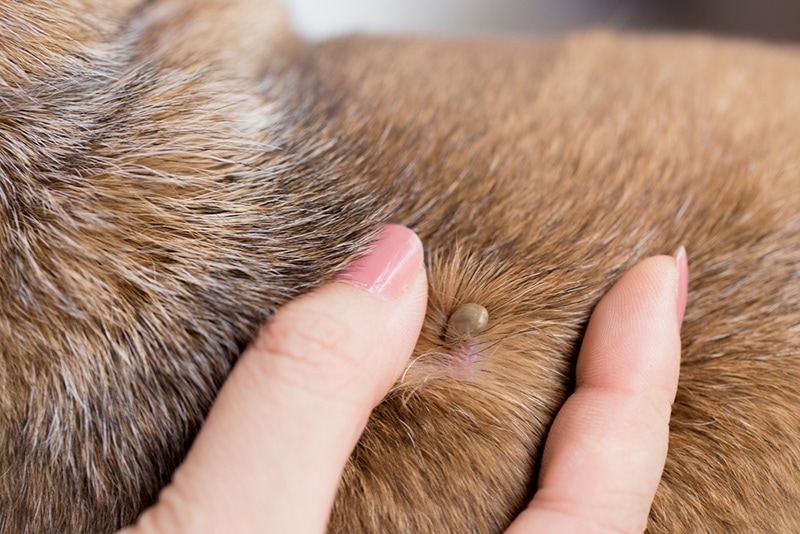Ehrlichiosis in Dogs: Signs, Causes & Treatment (Vet Answer)

Updated on

Click to Skip Ahead
Ehrlichiosis is a tick-borne infection spread to dogs by the brown dog tick. Rickettsial organisms are known to be responsible for the disease. Rickettsiae are a group of bacteria and Ehrlichia Canis is the most common species identified in Ehrlichiosis disease in dogs. The bacteria target the dog’s white blood cells and can make dogs very sick. Clinical signs seen include neurological problems, fever, swollen glands, and bleeding disorders. German Shepherds and Doberman Pinchers are known to be susceptible to chronic infections.
What Is Ehrlichiosis in Dogs?
Canine ehrlichiosis is a disease seen in dogs that is typically caused by the rickettsia Ehrlichia Canis.
Rickettsiae are a group of gram-negative bacteria that are characterized by the fact that they are intracellular, meaning they live inside other cells.1 They are found in mammals, but also in ticks, lice, mites, and fleas.
Genera include:
- Rickettsiae
- Ehrlichia
- Coxiella
- Orienta
Ehrlichia Canis targets and infects white blood cells—specifically monocytes. It is able to establish an infection that spreads into the blood system and travels around the body affecting various organs. It also has an effect on the platelets in the blood which causes clotting issues. It is not considered to be a primary zoonotic disease, although human infection has been reported.
It is commonly spread by the brown dog tick, but the black-legged tick and the lone star tick are also known to transmit the disease. Another species, Ehrlichia ewingii targets different white blood cells called granulocytes.

What Are the Signs of Ehrlichiosis in Dogs?
Clinical signs of Ehrlichiosis depend on the condition of the host dog’s immune system. If the dog is immunosuppressed in any way or is very young or old, they are less likely to cope with an infection.
Typical clinical signs seen include:
- Fever
- Pain
- Depression
- Lethargy
- Bleeding disorders
- Reduced appetite
- Changes in thirst or urination
- Weight loss
- Loss of muscle mass
- Enlarged lymph nodes
- General stiffness
- Vomiting
- Diarrhea
- Swollen/distended abdomen
- Cough
- Nasal discharge
- Ocular discharge
- Loss of sight
- Neurological issues
- Increased thirst and urination
- Swollen limbs
Clinical signs are very generalized and non-specific so Ehrlichiosis can be challenging to diagnose. If you have found a tick on your dog and you then see any of the above clinical signs, seek veterinary attention immediately.
There are acute and chronic forms of the disease. The clinical signs witnessed are dictated by the stage of the infection. They can occur at different rates in different dogs.
There can be acute, subclinical, and chronic stages.
- Acute stage: This occurs immediately after initial exposure. It usually lasts 2–4 weeks. Signs you may see include fever, depression, lethargy, reduced appetite, and swelling of palpable lymph nodes. If the disease is caught at this stage, it is fairly easy to treat. Some dogs will be able to fight off the infection on their own, if not the disease will head to the subclinical phase.
- Subclinical stage: There are no outward clinical signs noted in this stage. However, the disease is still well and truly present. This is extremely dangerous as the disease progresses undetected for a long period of time and becomes well-established. Owners will have no idea there is anything wrong with their dog due to the lack of clinical signs.
- Chronic stage: This occurs when the initial infection has been allowed to develop and progress, and the disease has become well-established. Clinical signs are more serious, including loss of sight, bleeding disorders, and neurological signs. The disease is much trickier to treat at this stage. If the bone marrow is affected, the dog is unable to produce new blood cells to keep functioning and the disease results in death.
What Are the Causes of Ehrlichiosis in Dogs?
Dogs contract Ehrlichiosis by getting bitten by an infected tick. Ticks that carry the disease are commonly seen in specific geographic areas. Your vet will be able to advise you if there are high numbers in your area. Any dog can contract Ehrlichiosis, although some breeds appear to be more susceptible than others, this includes German Shepherds and Doberman Pinchers. In very rare cases, dogs can become infected via a blood transfusion.
Ehrlichiosis Canis is usually transmitted by the brown dog tick. Ehrlichiosis ewingii is commonly transmitted by the lone star tick. Once a tick has attached to your dog, disease transmission can happen within 3 hours. This is why owners need to be vigilant with tick removal. Humans are not commonly affected by Ehrlichiosis Canis, however, they can be affected by other types of ehrlichiosis such as the E. Ewingii strain. The disease is not passed directly from dogs, but humans can get the disease from tick bites, the same way dogs do.

Diagnosis of Ehrlichiosis in Dogs
Your vet will obtain a detailed clinical history for your dog. This will include travel history and any parasites such as ticks seen on your dog. Your vet will perform a thorough physical exam to check your dog for any clinical signs.
Ehrlichiosis in dogs is definitively diagnosed using a blood test to detect the presence of antibodies to E. Canis. Antibodies to Ehrlichiosis develop over time, after exposure to the infection has occurred. Therefore, lots of dogs with the disease may test negative in the early stages before antibodies are formed. If clinical signs are indicative of Ehrlichiosis, your vet will arrange a subsequent blood test in a few weeks to retest for antibodies. There are specialist tests called PCR (polymerase chain reaction) and ELISA (enzyme-linked immunosorbent assays) that can test which species of Ehrlichiosis is present.
Routine blood and urine tests will also be carried out for a baseline evaluation to assess white blood cell and red blood cell counts and also to assess organ function amongst other things. Significant findings include:
- Reduced platelet count
- Anemia
- Increased levels of globulin protein
Sometimes clinicians may see the organism present in blood smears or other samples, however, this is very uncommon.
How Do I Care for a Dog with Ehrlichiosis?
If the infection is caught in the early stages, a course of antibiotics is prescribed. Doxycycline is usually the chosen antibiotic. This is due to the fact it is a good drug for intracellular penetration and has good bacteriostatic properties against rickettsia. Tetracycline can also be used. A long course is required, usually at least a month.
If the dog is in the chronic stages, treatment is more of a challenge. Depending on what state the dog is in, treatment such as intravenous fluids, tube feeding, blood transfusions, and long-term hospitalization may be required. Secondary infections may have developed which will need addressing. Pain relief is often required and broad-spectrum antibiotics may be required.

Frequently Asked Questions (FAQs)
Can humans catch Ehrlichiosis from their dogs?
It is not possible to catch Ehrlichiosis directly from your dog, however, humans are able to contract the disease from tick bites in the same way that dogs do. The only way the disease is spread is via tick bites. If you are in an area where other dogs are getting infected, be extra cautious as this means you and your dog are both at risk of being bitten by infected ticks.
How can I protect my dog from Ehrlichiosis?
It is not possible to fully protect your dog from the risks of Ehrlichiosis, however, there are ways you can minimize the risk of them contracting the disease. Limit your dog’s exposure to ticks in any way you can. This involves avoiding woody areas or tall grass in peak season. Keep grass and shrubs in your garden trimmed down and discourage your dog from going in them.
Check your dog regularly for ticks and remove any ticks safely using a tick twister tool or tweezers. Do not attempt to pull the tick out directly if you are not confident removing ticks—arrange an appointment with your vet and they can safely remove it ensuring the mouthpiece is removed too. Use a tick-prevention product regularly. Your vet will be able to prescribe you a suitable one for your dog’s age and weight.
What’s the prognosis in dogs?
If your dog has been diagnosed with Ehrlichiosis, a prolonged course of treatment will be prescribed. If your dog is caught in the acute stages, after treatment with appropriate antibiotics, your dog should make a full recovery. If your dog is in the chronic stages of infection, recovery is much more complicated and there is a more guarded prognosis.

Conclusion
In general, the prognosis for dogs with Ehrlichiosis is determined by the stage of the infection and how many organs are affected in the body. Dogs receiving treatment in the acute stages of the disease have a good recovery rate. Chronic cases provide more of a challenge, and they can unfortunately result in death if left untreated. Reinfection is possible, as immunity to the bacteria is short-lived.
Prevention is better than cure and there are several effective measures you can take to reduce tick exposure for your dog.
Featured Image Credit: W_NAMKET, Shutterstock












